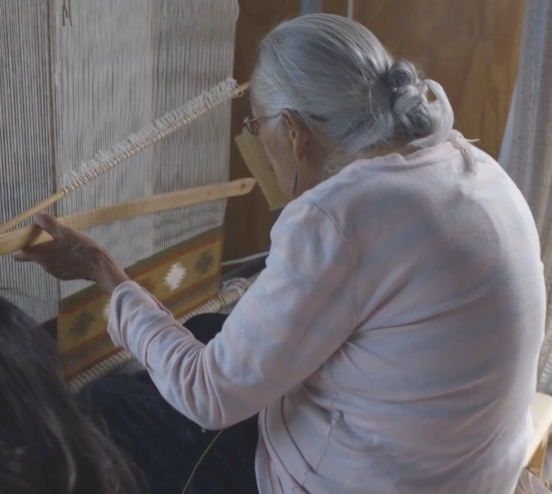
Documentary | Festival Interviews | Filmmaking | Interviews | Massachusetts
2020 Festival Film: Irene H. Clark, Master Navajo Weaver
Dan Harris's short documentary screens at the Online New England Film Festival.
Written by Hope Johnson | Posted by: NewEnglandFilm.com Festival
NewEnglandFilm.com talks with Dan Harris about his film Navajo Master Weaver Irene H. Clark, which screens in the 2020 Online New England Film Festival.
Filmmaker Dan Harris explores the ties of family and art in the short documentary Navajo Master Weaver Irene H. Clark, which screened at Salem Film Festival’s Mass Reality Check Competition and now is screening at the Online New England Film Festival. Harris talks about his inspiration for the film and more in this interview with NewEnglandFilm.com.
NewEnglandFilm.com: When did you know you wanted to become a filmmaker?
Dan Harris: I dropped out of college for medical reasons in 2014, and spent some time healing out in the deserts and mountains of Colorado, Utah, and Arizona. During that time I had no idea what I wanted to do with myself, and I was focusing on moving past my own challenges.
During that process, I took thousands of photos and wrote hundreds of pages in my journal about the incredible things I saw, the remarkable people I met, and the meaningful connections I made as I began to understand the power of that landscape.
Filmmaking was never the goal, it was something I wandered into that sort of just clicked for me as the most effective medium to share the stories that I believe are important, and I figured that out when I was out in the wilderness. I began to experiment with my own documentary process before making the decision to return to school as part of Fitchburg State’s Communications Media program in 2017. There were stories out there in the wilderness that I wanted to share, and filmmaking was how I chose to tell them.
NewEnglandFilm.com: What inspired you to make your film?
Harris: During the summer of 2018, I worked as an outdoor educator for a non-profit guiding company called Deer Hill Expeditions. As part of my work, I led high school students on cross-cultural immersion expeditions out in the Navajo Nation with our educational partners and Navajo hosts Gwen and Ferlin Clark, who are themselves professional educators.
Living with the Clark family alongside my students, we learned from them about Navajo culture, art, history, and life, and all of us soon became good friends. It was an incredibly moving and powerful experience for both myself and my students, and I wanted to share this with others through a collaboratively created film. Enamored with the rare and incredible weaving art and knowledge of Ferlin’s mother Irene, we discussed the possibility of my senior thesis project at Fitchburg State University being a film about her life and art. In December of 2018, my crew at Fitchburg State University began production work with the Clark family to tell Irene’s amazing story.
NewEnglandFilm.com: Where has the film been shown? What was that experience like?
Harris: The film has been shown at Salem Film Festival’s Mass Reality Check Competition, VISIONS 2020 (Fitchburg State University’s honors exhibition for Communications Media). A fun memorable moment that I like to share is when I showed the film at a family gathering, and a few of my very young cousins under five years old were mesmerized watching Irene weave at her loom.
NewEnglandFilm.com: How does your film fit into today’s current social and political moment?
Harris: What I believe makes Irene and all of the Clark family special is that no matter who you are or where you come from, they will always welcome anyone into their home, share a meal, and make you a part of their family. They carry this deeper sense of love for all people and instill that in the students they educate, something which I find extremely grounding, especially in a very turbulent era of American history where the country is disastrously divided along racial, economic, and political lines.
What continues to amaze me is how very few Americans are aware that the Navajo Nation and surrounding reservations are a country inside of the United States the size of West Virginia with a population of roughly 350,000 people, and how little exposure it receives in mainstream American media. While the film itself was made before the COVID-19 Pandemic, I think it is worth noting that the Navajo Nation continues to have the highest rate of infection and deaths from the virus in the entire continental US, and if I can help draw attention to that by writing this, then I will.
Learning firsthand from the Clarks about Navajo culture, history, traditions, thinking, and current issues, I feel that I now have a greater understanding of America’s identity as a whole, they’ve made me love my country and what exists here in a way that I never thought possible, and I hope that’s something which viewers will take away from the film as well.
NewEnglandFilm.com: What do you hope people take away from watching your film?
Harris: Fundamentally, I want viewers to feel that they know and appreciate Irene and her family, who they are as people, as teachers, and how their weaving art is a physical manifestation of their history, traditions, knowledge of the landscape, and love for one another. The goal is to have people see these special rugs and tapestries as not just physical objects, but everything beautiful that they represent. Throughout the film, we see the Clark Family go through the entire creative process together. Everyone picks the dyeing ingredients from the landscape, the sheep’s wool is raised and carded, they build the fire together, and make their loom together, and truly embody the idea of “it takes a village” in their craft. It’s difficult for me to describe and impossible to word correctly, but I want viewers of this film to feel the way my students and I felt, and to learn the things we learned when we lived with the Clarks out on their land in Bowl Canyon. I think if I can accomplish that, then I’ve done my job.
NewEnglandFilm.com: How did you find your cast and crew for this film?
Harris: I crewed up with Connor Murphy, Johnny Gifford, and Matt Smith who are friends and fellow students of mine at Fitchburg State University, all of them fantastically talented filmmakers that I asked to be a part of this project because I knew that they would see the deeper meaning behind it, and would put the work in to do the story justice. Less of a “cast” and more our collaborators, the Clarks are friends of mine who I worked with as educational partners during my work with Deer Hill Expeditions in 2018 as an outdoor educator, an organization through which together we ran a cross-cultural immersion expedition for high school students from across the United States.
NewEnglandFilm.com: What other projects are you working on?
Harris: Currently, I am working on the principal photography for an abstract stop-motion animated film about my experience undergoing acute malpractice-induced benzodiazepine withdrawal. It aims to shed light on a poorly understood and highly stigmatized dysfunction of psychiatric prescribing practices in the United States, and the patients who are harmed by it. The film involves a wire armature, animations built in Photoshop and AfterEffects, and a patchwork of audio testimonials from myself and other patients who were accidentally sent into severe withdrawal from these common and deadly psychiatric prescribing errors. It’s a project that is very challenging for me to make, but a story I am eager to tell.
NewEnglandFilm.com: Any advice on making films you want to share?
Harris: As cliche as it sounds, follow your heart and go after project ideas that resonate with your soul. Filmmaking is a long process of hard passionate work, so if you’re going to put the blood, sweat, and tears into a project, make sure it’s something that makes you want to shout “Hey, I have something to say!” Another piece of advice I’d like to pass on from my awesome lighting and cinematography professor Zak Lee at Fitchburg State: “Always know less than the people you’re working with.” It’s a great piece of advice in the sense that it means you should work with people who you know can teach you things. For example, Johnny Gifford our Audio Recordist, Sound Designer, and Composer for the film taught me so much about field capture for audio and scoring a film, so I learned a ton of things about sound in general from him on this project.
Another big thing I would say, is to set goals that are out of your comfort zone! Before I even knew how to produce the film, I told Irene and her family that I would fly a crew down to Crystal New Mexico and that we would work with them to make this production happen. I had no idea how much plane tickets would be, I’d never rented a vehicle, I’d never traveled with so many expensive pieces of equipment… did we need insurance? What type? There were tons of huge scary problems ahead of us, but I realized that this giant and seemingly insurmountable goal was made up of smaller and more manageable goals. We worked on solving those problems as a team and gave ourselves six whole months to do so before our shooting deadline.
So I would say the best piece of advice I have when it comes to producing, is to give yourself plenty of time to work diligently and figure things out, and to do so with a good team to support you. We used Indiegogo in combination with a social media campaign on Facebook and Instagram to raise the money we needed to make the film happen. Social media and creating small pieces of original supportive content is the most effective strategy to independently produce your own film projects, in my experience.
NewEnglandFilm.com: Anything else you want to share that might be of interest to our readers?
Harris: Overall, I would echo what I said earlier; that the most important thing you can do as a filmmaker is to pursue a project that resonates with your soul, and makes you feel something powerful. I believe documentaries like Irene H. Clark; Master Navajo Weaver work best when you are able to harness that energy, while still maintaining the awareness to keep yourself from becoming the subject of a film about someone else’s story. When it’s a subject you care about, this can be very hard to do and it’s something that I struggled with for a long time. This project in particular was a huge challenge in that way for me. The deserts of the Southwest, the Navajo Nation, that entire landscape and the people who live there are all things with tremendous meaning in my own life, but this film is not about me. It’s Irene’s story, and it’s a story about the people who understand that landscape and its meaning better than anyone else.
Building off of that, I also believe that biographical films and artist’s profiles like this tend to work best when you take a collaborative approach to production with the artists involved. If you want the voice of the subject to ring true and authentic, your job as a director is to amplify their voice, not re-shape it to what you want it to be, or what you believe it to be. Immerse yourself in their world first, and put the work into understanding their perspective, read a ton, and do your research. I’ve maintained this collaboration by including documentary subjects in brainstorming and writing sessions, rough-cut reviews and feedback, and by structuring interviews as flowing conversations rather than line-by-line interrogations. If you’ll notice in the credits of the film, Gwen and Ferlin Clark are included as crew members on the project, because they were critical in all aspects of the filmmaking process from the beginning.
The great thing about making documentaries is that anybody can do it, and the artists you work with and profile in this format can become filmmakers with you. Another thing I’ve learned the hard way as an inexperienced documentarian is that there is huge freedom in letting go of your idea of what you want the film to be in the beginning of the process, and instead choosing to find excitement in the natural evolution of your work through pre production, shooting, and editing. A subject could drop off the project last-minute, a weather event could impact a shoot, or you could capture something wonderful you didn’t expect. Any number of things could shape the content for better or for worse, and making good documentaries I think, lies in how you adjust to that. What I find exciting about making documentaries is that I never know what I’m going to end up with, and instead of choosing to view that as something stressful, I see it as a new adventure.
One of the most important difficult things I also learned through past projects as a director is that you need to let go of some creative control over your film! Recognize the talent and judgment of the people you’re working with and trust them to make creative decisions. Filmmaking is a collaborative effort where multiple voices enhance the quality of your final cut. On every single film project you lead, the people working “under” you will come up with fantastic ideas that you yourself would never think of. Your job as a director in that sense is to create a space where your crew can be as creative as possible. No matter the medium through which you make a documentary, I always think back to the mantra of one of my mentors Doug Capelin, the founder of Deer Hill Expeditions where I first worked as an outdoor educator: “Listen actively to the people around you, and speak from the heart.”
Irene H. Clark, Master Navajo Weaver screens at the 2020 Online New England Film Festival at NewEnglandFilm.com.










